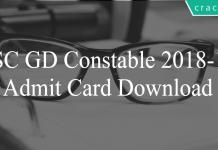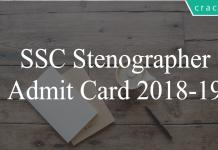Expected Quant Questions For SSC CHSL PDF
Expected Quant Questions for SSC CHSL download PDF based on previous year question paper of SSC exams. 20 Very important Expected Quant questions for SSC CHSL Exam.
Download Expected Quant Questions For SSC CHSL PDF
Take a free mock test for SSC CHSL
Download SSC CHSL Previous Papers
More SSC CHSL Important Questions and Answers PDF
Question 1: Find the value of $\frac{(243)^\frac{n}{5}\times3^{2n+1}}{9^{n}\times3^{n-1}}$
a) 3
b) 9
c) 27
d) 4
Question 2: If for a non-zero x, 3$x^{2}+5x + 3 = 0$, then the value of $\ x^{3}+\frac{1}{x^{3}}$ is:
a) $\frac{10}{27}$
b) $-(\frac{10}{27})$
c) $\frac{2}{3}$
d) $-(\frac{2}{3})$
Question 3: The ratio of the volume of a cube to that of a sphere which will fit inside the cube is
a) 4 : $\pi$
b) 4 : $3\pi$
c) 6: $\pi$
d) 2 : $\pi$
Question 4: A string of length 24 cm is bent first into a square and then into a right-angled triangle by keeping one side of the square fixed as its base. Then the area of triangle equals to:
a) 24 cm$^{2}$
b) 60 cm$^{2}$
c) 40 cm$^{2}$
d) 28 cm$^{2}$
Question 5: The red blood cells in a blood sample grows by 10% per hour in first two hours, decreases by 10% in next one hour, remains constant in next one hour and again increases by 5% per hour in next two hours. If the original count of the red blood cells in the sample is 40000, find the approximate red blood cell count at the end of 6 hours.
a) 40000
b) 45025
c) 48025
d) 50025
SSC CHSL Study Material (FREE Tests)
Question 6: The compound interest on a sum of Rs. 5000 at 8% per annum for 9 months when interest is compound quarterly is:
a) Rs. 300
b) Rs. 300.12
c) Rs. 306.04
d) Rs. 308
Instructions
Question 7: If an arc subtends an angle of 45 degrees at the center of the circle then what is the ratio of length of the arc to the diameter of the circle ?
a) 11:26
b) 11:24
c) 11:28
d) 11:20
Question 8: Perimeter of a rectangle is 24 cm and area of the square having diagonal equal to the breadth of the rectangle is 32 sq cm. What is the area of the rectangle ?
a) 32 sq cm
b) 64 sq cm
c) 16 sq cm
d) 24 sq cm
Question 9: In a triangle ABC,Angle bisector of A intersects the side BC at E and if AB=6 cm and AC =14 cm, EC=7 cm then the value of BC is
a) 11
b) 13
c) 14
d) 10
Question 10: Two sides of the triangle are 8 cm and 10 cm and the angle included between them is 60 degrees then what is the value of third side ?
a) $\sqrt{84}$
b) $\sqrt{82}$
c) $\sqrt{80}$
d) $\sqrt{86}$
Instructions
Question 11: Which of the following is least ?
$\frac{17}{13},\frac{18}{15},\frac{15}{9},\frac{12}{7}$
a) $\frac{17}{13}$
b) $\frac{18}{15}$
c) $\frac{15}{9}$
d) $\frac{12}{7}$
Question 12: Which of the following is greatest ?
$\frac{982}{45},\frac{43}{2},\frac{598}{28},\frac{1000}{47}$
a) $\frac{43}{2}$
b) $\frac{982}{45}$
c) $\frac{598}{28}$
d) $\frac{1000}{47}$
Question 13: Which of the following is greatest ?
$\frac{207}{11},\frac{37}{2},\frac{117}{6},\frac{427}{24}$
a) $\frac{37}{2}$
b) $\frac{427}{24}$
c) $\frac{207}{11}$
d) $\frac{117}{6}$
Question 14: Which of the following is least ?
$\frac{11}{5},\frac{10}{4},\frac{23}{11},\frac{31}{14}$
a) $\frac{11}{5}$
b) $\frac{10}{4}$
c) $\frac{23}{11}$
d) $\frac{31}{14}$
Question 15: Which of the following is greatest ?
$\frac{58}{8},\frac{96}{13},\frac{38}{5},\frac{89}{14}$
a) $\frac{58}{8}$
b) $\frac{96}{13}$
c) $\frac{38}{5}$
d) $\frac{89}{14}$
Question 16: Which of the following is greatest ?
$\frac{123}{11},\frac{80}{7},\frac{57}{5},\frac{213}{19}$
a) $\frac{123}{11}$
b) $\frac{80}{7}$
c) $\frac{57}{5}$
d) $\frac{213}{19}$
Question 17: Which of the following is greatest ?
$\frac{73}{13},\frac{87}{16},\frac{51}{9},\frac{120}{23}$
a) $\frac{73}{13}$
b) $\frac{87}{16}$
c) $\frac{51}{9}$
d) $\frac{120}{23}$
Question 18: Which of the following is greatest ?
$\frac{42}{23},\frac{31}{20},\frac{57}{36},\frac{82}{51}$
a) $\frac{57}{36}$
b) $\frac{31}{20}$
c) $\frac{42}{23}$
d) $\frac{82}{51}$
Question 19: Which of the following is greatest ?
$\frac{17}{21},\frac{23}{27},\frac{19}{23},\frac{21}{25}$
a) $\frac{17}{21}$
b) $\frac{23}{27}$
c) $\frac{19}{23}$
d) $\frac{21}{25}$
Question 20: Which of the following is greatest ?
$\frac{7}{13},\frac{8}{15},\frac{5}{9},\frac{12}{21}$
a) $\frac{7}{13}$
b) $\frac{8}{15}$
c) $\frac{5}{9}$
d) $\frac{12}{21}$
FREE SSC MATERIAL – 18000 FREE QUESTIONS
Answers & Solutions:
1) Answer (B)
Expression : $\frac{(243)^\frac{n}{5}3^{2n+1}}{9^{n}3^{n-1}}$
= $\frac{(3^5)^\frac{n}{5}\times3^{2n}\times3}{3^{2n}\times3^{n}\times3^{-1}}$
= $\frac{3^{n+2n}\times3}{3^{n+2n}\times3^{-1}}$
= $\frac{3^{3n}}{3^{3n}}\times3\times\frac{1}{\frac{1}{3}}$
= $3\times3=9$
=> Ans – (B)
2) Answer (A)
Given : $3x^2+5x+3=0$
Divide by $x$, => $3x+\frac{3}{x}=-5$
=> $x+\frac{1}{x}=\frac{-5}{3}$ ————-(i)
Cubing both sides, we get :
=> $(x+\frac{1}{x})^3=(\frac{-5}{3})^3$
=> $x^3+\frac{1}{x^3}+3(x)(\frac{1}{x})(x+\frac{1}{x})=\frac{-125}{27}$
=> $x^3+\frac{1}{x^3}+3(1)(x+\frac{1}{x})=\frac{-125}{27}$
=> $x^3+\frac{1}{x^3}+3(\frac{-5}{3})=\frac{-125}{27}$
=> $x^3+\frac{1}{x^3}=\frac{-125}{27}+5$
=> $x^3+\frac{1}{x^3}=\frac{-125+135}{27}$
=> $x^3+\frac{1}{x^3}=\frac{10}{27}$
=> Ans – (A)
3) Answer (C)
Let edge of cube be $2a$ cm and thus diameter of sphere = $2a$ cm
=> Radius of sphere = $\frac{2a}{2}=a$ cm
Volume of cube = $(2a)^3=8a^3$ $cm^3$ ———–(i)
Volume of sphere = $\frac{4}{3}\pi r^3$
= $\frac{4}{3} \pi \times(a)^3=\frac{4a^3\pi}{3}$ $cm^3$ ———–(ii)
Dividing equation (i) by (ii), we get :
=> Required ratio = $\frac{8a^3}{\frac{4a^3\pi}{3}}$
= $\frac{8\times3}{4\pi}=\frac{6}{\pi}$
$\therefore$ Ratio of the volume of a cube to that of a sphere which will fit inside the cube = $6:\pi$
=> Ans – (C)
DOWNLOAD APP TO ACESSES DIRECTLY ON MOBILE
4) Answer (A)
String of length 24 cm is bent into square, => Perimeter of square = 24 cm
Let side of square = $a$ cm
=> $4a=24$
=> $a=\frac{24}{4}=6$ cm
Let the other side of triangle be $b$ and hypotenuse be $c$ cm
=> Perimeter of triangle = $a+b+c=24$
=> $b+c=24-6=18$
=> $c=18-b$ ————(i)
Also, using Pythagoras Theorem
=> $6^2+b^2=c^2$
=> $c^2-b^2=36$ ———–(ii)
Solving equations (i) and (ii), we get : $b=8$ cm and $c=10$ cm
$\therefore$ Area of triangle = $\frac{1}{2} ab$
= $\frac{1}{2}\times6\times8=24$ $cm^2$
=> Ans – (A)
5) Answer (C)
Original count = 40,000
In the next 2 hours, it increases by 10%
=> Blood cell count after 2 hours = $40,000(1+\frac{10}{100})^2=40,000(\frac{11}{10})^2$
= $40,000\times\frac{121}{100}=48,400$
It decreases by 10% in next hour
=> Blood cell count after 3 hours = $48,400(1-\frac{10}{100})^1$
= $48,400\times\frac{9}{10}=43,560$
It remains constant in the next hour, => Blood cell count after 4 hours = $43,560$
In the next 2 hours, it increases by 5%
=> Blood cell count after 6 hours = $43,560(1+\frac{5}{100})^2=43,560(\frac{21}{20})^2$
= $43,560\times\frac{441}{400}=48,024.9\approx48,025$
=> Ans – (C)
6) Answer (C)
Principal sum = Rs. 5000
Rate of interest = 8% and time period = $\frac{9}{12}=\frac{3}{4}$ years
Compound interest when interest is compound quarterly = $P[(1+\frac{R}{400})^{4T}-1]$
= $5000[(1+\frac{8}{400})^{\frac{3}{4}\times4}-1]$
= $5000[(1+\frac{1}{50})^3-1]$
= $5000[(\frac{51}{50})^3-1]$
= $5000\times(\frac{132651-125000}{125000})$
= $\frac{7651}{25}=Rs.$ $306.04$
=> Ans – (C)
7) Answer (C)
Length of the arc if it subtends x degrees at the center is $\frac{x}{360}\times2\times\pi\times r$
Here x=45 degrees
Required ratio= $\frac{\frac{45}{360}\times2\times\pi\times r}{2r}$
=$\pi/16$
=11:28
8) Answer (A)
Given 2(l+b)=24
l+b=12
Given b=diagonal of square
$d^{2}/2$=32
$d^{2}$=64
d=8 cm
b=8 cm
l+8=12
l=4 cm
Area of the rectangle=l*b
=4*8
=32 sq cm
9) Answer (D)
In a triangle internal angular bisector divides the opposite side in the ratio of other sides.
Therefore AB/AC=BE/EC
6/14=BE/7
BE=3 cm
BC=BE+EC
=7+3
=10 cm
10) Answer (A)
From cosine rule we have $a^{2}$=$b^{2}+c^{2}-2bc\cos A$
$a^{2}$=64+100-(2*8*10*1/2)
$a^{2}$=84
a=$\sqrt{84}$
11) Answer (B)
$\frac{17}{13}$=1.30
$\frac{18}{15}$=1.2
$\frac{15}{9}$=1.66
$\frac{12}{7}$=1.71
12) Answer (B)
$\frac{43}{2}$=21.5
$\frac{982}{45}$=21.82
$\frac{598}{28}$=21.35
$\frac{1000}{47}$=21.27
13) Answer (D)
$\frac{37}{2}$=18.5
$\frac{427}{24}$=17.8
$\frac{207}{11}$=18.8
$\frac{117}{6}$=19.5
14) Answer (C)
$\frac{11}{5}$=2.10
$\frac{23}{11}$=2.09
$\frac{10}{4}$=2.5
$\frac{31}{14}$=2.2
15) Answer (C)
$\frac{58}{8}$=7.25
$\frac{96}{13}$=7.38
$\frac{38}{5}$=7.6
$\frac{89}{14}$=6.35
16) Answer (B)
$\frac{123}{11}$=11.18
$\frac{80}{7}$=11.42
$\frac{57}{5}$=11.40
$\frac{213}{19}$=11.21
17) Answer (C)
$\frac{73}{13}$=5.61
$\frac{87}{16}$=5.43
$\frac{51}{9}$=5.66
$\frac{120}{23}$=5.21
18) Answer (C)
$\frac{42}{23}$=1.82
$\frac{31}{20}$=1.55
$\frac{57}{36}$=1.58
$\frac{82}{51}$=1.60
19) Answer (B)
$\frac{17}{21}$=0.809
$\frac{23}{27}$=0.851
$\frac{19}{23}$=0.826
$\frac{21}{25}$=0.84
20) Answer (D)
$\frac{7}{13}$=0.538
$\frac{8}{15}$=0.533
$\frac{5}{9}$=0.555
$\frac{12}{21}$=0.57





